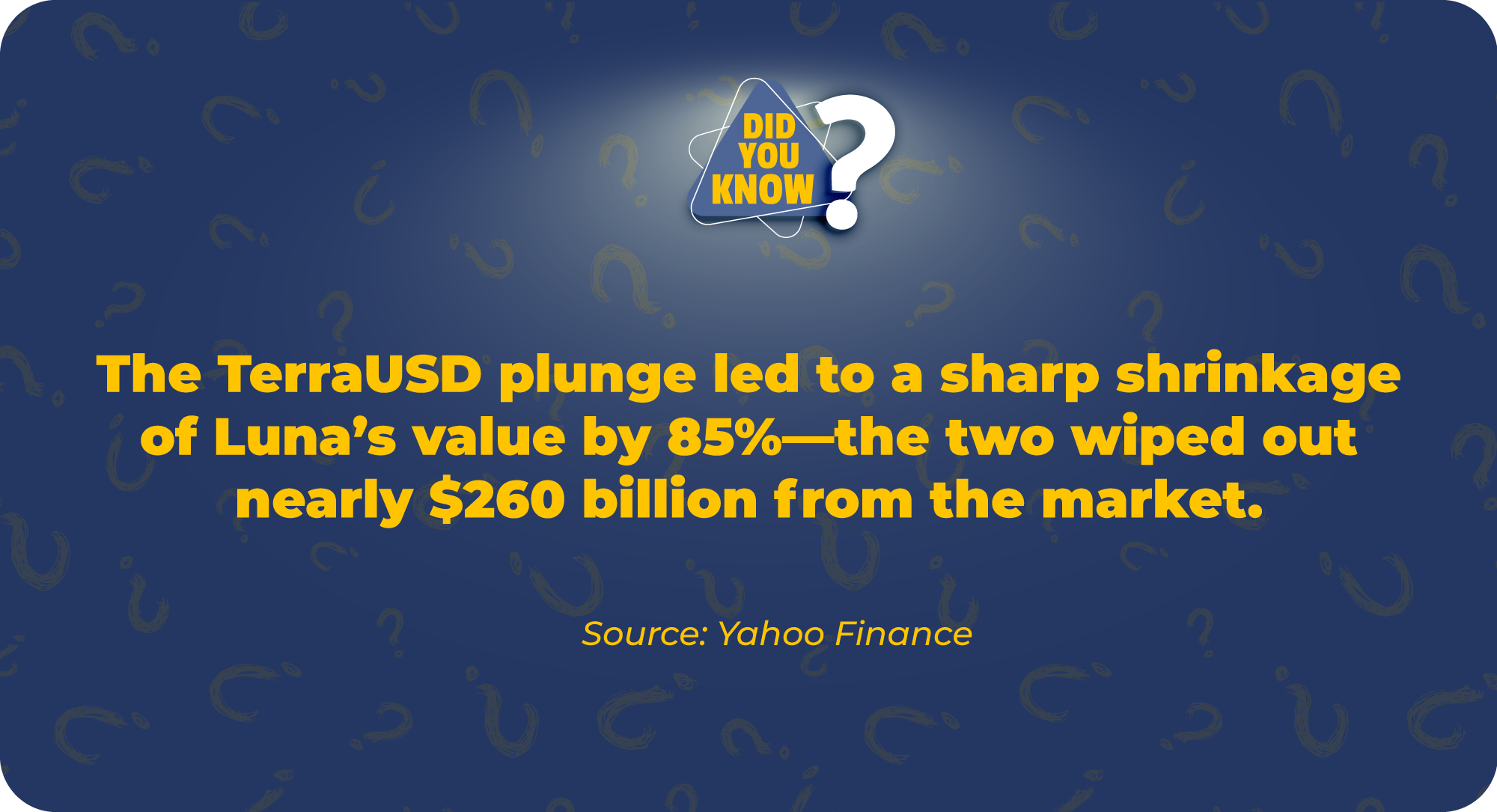
Since the introduction of Bitcoin in 2009, cryptocurrency has evoked both excitement and scepticism. This decentralised digital currency had the potential to revolutionise the financial sector, driving its surging popularity through the 2010s. In 2018, the market capitalisation of crypto reached $820 billion. The crypto market has been experiencing exponential growth since, even after multiple scams surfaced in the form of bogus Initial Coin Offerings (ICOs) and phishing attacks. However, 2022 has been a tumultuous year for crypto, with digital currencies witnessing unprecedented highs and unfathomable lows in just a few months. Let’s look at the top 5 events that made 2022 a landmark year for cryptocurrencies.
1. The tragedy of stablecoins
A stablecoin, a crypto that can be mined or bought, is meant to have a stable value. By pegging, backing, or reserving it to an underlying commodity or currency, it is possible to ensure the stability of a stablecoin.
While this sounds somewhat reassuring, all of the trust in stablecoins came to nought following the sudden collapse of TerraUSD, a stablecoin designed to function like cash. Pegged to the US dollar, TerraUSD was supposed to maintain a stable value of $1 per coin. However, in May 2022, its value crashed from $1 to 3 cents, leaving investors baffled. One reason cited by experts for the dramatic fall of these cryptocurrencies in 2022 is that TerraUSD was an algorithmic stablecoin. This means it was not backed by any real asset. The panic caused by the collapse of TerraUSD led to the virtual demise of another stablecoin pegged to TerraUSD, Luna.

2. Volatility all the way down
If there’s one thing that has been a defining feature of cryptocurrencies, it is volatility. The underlying asset’s value determines the price and returns of any financial asset, such as a company stock or a government bond. As no underlying asset supports most cryptocurrencies, their prices are determined purely by the forces of demand and supply. Investors in crypto rely on speculation, making the price of a cryptocurrency hostage to the whims and fancies of investors.
Titan, a crypto-token, lost all value in 2021 when investors dumped the tokens for profits after its price skyrocketed. Even Bitcoin has been experiencing wild fluctuations for the past couple of years. In 2021, its value fell steeply by 30%, hitting $30,000, following a significant selling frenzy in the market. This was when the bear market was developing and many raised concerns regarding Bitcoin’s environmental, social, and governmental (ESG) viability. It limped to $38,000 as markets recovered. Cryptocurrencies in 2022 did not fare well, either. Ethereum, the most popular crypto after Bitcoin, lost 67% of its value, while Solana and AMP lost 93% each. These numbers show that the value of the cryptocurrency you hold is susceptible to investors’ perceptions and expectations. If you are a risk-averse individual, staying away from crypto is in your best interests.
3. A tale of two bankruptcies
The spectacular nature of bankruptcies filed by crypto companies has made 2022 an even more agonising year for the cryptocurrency market. The biggest and the most shocking of these was the fall of FTX, one of the globe’s largest crypto platforms. Once valued at $32 billion, FTX filed for bankruptcy in November 2022 after Binance, another crypto exchange, pulled out of an acquisition deal. Consequently, FTX users started quitting the platform, withdrawing funds roughly to the tune of $6 billion.
Second in line to FTX was the bankruptcy filing by Core Scientific, one of the largest publicly traded crypto mining companies in the US. From a valuation of $4.3 billion in July 2021, Core’s market cap plummeted to $78 million in December 2022. Its stock dropped by 98% during the year. According to the company, the reasons for this astounding decline include increasing energy prices (which have made crypto mining expensive) and falling prices of cryptocurrencies in general.
4. Quelling the crypto mania
Investment tycoons went on record discrediting cryptocurrencies in 2022. In June, Bill Gates called cryptocurrencies and their variants ‘shams based on the greater-fool theory’. This theory states that the price of overvalued assets will continue to rise since more people are willing to pay more for such assets. Warren Buffet has been even more caustic with his scepticism of crypto. At the annual Berkshire Hathaway shareholders’ meeting in May 2022, the iconic investor compared Bitcoin with farmland, saying that farmland is a productive asset that has an intrinsic value; the value of Bitcoin, on the other hand, ‘depends on the next guy paying you more than the last guy got’.
Vitalik Buterin, the creator of the blockchain Ethereum platform, expressed his fear and dread about crypto in an interview with Time in March 2022. According to him, although crypto has made finance more transparent and accessible, it has also facilitated tax evasion and money laundering. Moreover, the crypto market has allowed a small group of people to become filthy rich. These voices of doubt, dissent, and distrust will be instrumental in tempering the rising tide of crypto.
5. Tax it or ax it
Given the magnitude of disruption crypto can cause to the overall economic health of a country, governments around the world are coming up with laws to tax crypto transactions, which is also the most efficient way to regulate the market at present. India, for example, announced in its Budget 2022 that any income accrued from cryptocurrency transfers would incur a flat tax of 30%. Additionally, the government would apply a Tax Deducted at Source (TDS) of 1% on any crypto payment. Developed countries like Germany, Canada, and the UK have been taxing crypto for several years. While these countries attempt to regulate crypto through taxes, others have outright banned these currencies. For instance, in 2022, Russia banned crypto, claiming that it threatened the country’s financial stability and security. Similarly, the Central Bank of Bolivia decided to impose a complete prohibition on cryptocurrencies in 2022.
A ray of hope

Originally, digital currencies powered by blockchain aimed at bringing transparency to financial transactions. Unfortunately, extreme volatility and sudden bankruptcies have tarnished the image of crypto, forcing countries to take harsh measures to either remove or regulate these assets. However, a ray of hope still seeps through the gloomy clouds of speculation. While some countries are oppressively taxing crypto or simply banning it altogether, many are emerging as tax havens for these assets. For instance, individual investing and crypto trading are tax-free in Switzerland and Singapore. Other countries, such as Portugal, Malta, Germany, and Belarus, also have crypto-friendly tax regulations. Crypto investors are thus not wholly abandoned. Additionally, there is a high likelihood that they will pull their monies out of crypto-wary economies and inject them into more welcoming regimes. Whether this potential exodus impacts other investment avenues in countries remains to be seen.


